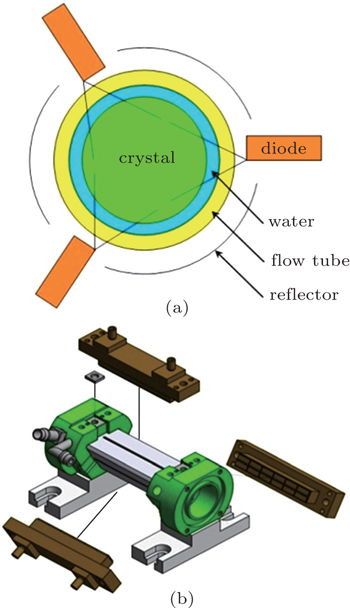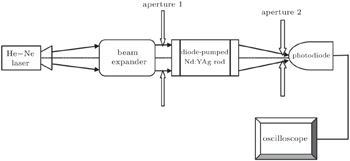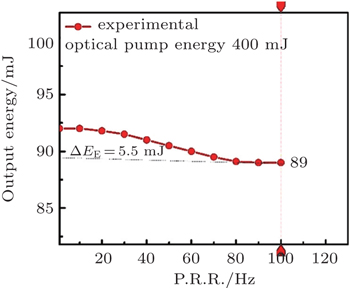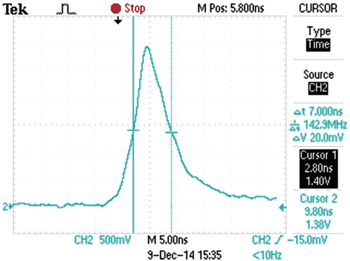† Corresponding author. E-mail:
We report the specification of a compact and stable side diode-pumped Q-switched pulsed Nd:YAG laser. We experimentally study and compare the performance of the pulsed Nd:YAG laser in the free-running and Q-switched modes at different pulse repetition rates from 1 Hz to 100 Hz. The laser output energy is stabilized by using a special configuration of the optical resonator. In this laser, an unsymmetrical concave–concave resonator is used and this structure helps the mode volume to be nearly fixed when the pulse repetition rate is increased. According to the experimental results in the Q-switched operation, the laser output energy is nearly constant around 70 mJ with an FWHM pulse width of 7 ns at 100 Hz. The optical-to-optical conversion efficiency in the Q-switched regime is 17.5%.
In recent years, diode-pumped solid-state laser (DPSSL) systems have been developed. Efficient, high pulse repetition rate (P.R.R) lasers in the nanosecond regimes are widely applied in scientific, medicine, military, and spectroscopy applications. In remote sensing, high peak power, short-pulse width, and high P.R.R. laser is especially required for reliable detection of targets and range finding.[1–5] One of the best types of such sources is the Nd:YAG laser pumped by quasi-continuous wave diode laser bars.[6–8] During the past years, much research has been carried out on the generation of Q-switched Nd:YAG lasers with side-pumped structure. Sun et al. characterized a side-pumped 0.5 J pulse Nd:YAG laser at 100 Hz with 80 ns pulse width.[9] Zhang et al. illustrated a Q-switched Nd:YAG laser of 61 mJ and 5 ns at 100–500 Hz.[10] They applied a convex–flat resonator with a length of 145 mm. Qi et al. demonstrated a high-energy laser diode side-pumped active Q-switched Nd:YAG ceramic laser with 50 mJ output energy and 10 ns pulse width at 100 Hz.[11] Sabaghzadeh et al. presented a uniformly three-side-pumped Nd:YAG laser.[12]
In this paper, a single head, uniformly three-side diode-pumped, pulsed Nd:YAG laser is used, and about 70 mJ energy per pulse with 7 ns pulse width at 100 Hz is obtained, which corresponds to an average power of 7 W and a peak power of 10 MW. The laser performance is evaluated under free-running and electro-optical Q-switched regimes. The output energy is stabilized by using an unsymmetrical concave–concave structure. The geometrical configuration of the resonator is designed in such a way that the spot size and the output energy are approximately unaffected by the change of P.R.R. from 1 Hz to 100 Hz. Therefore, this stable system is a suitable candidate for laser range-finder and LIDAR systems.
The experimental setup of a side-pumped electro-optical Q-switch Nd:YAG laser is shown schematically in Fig.
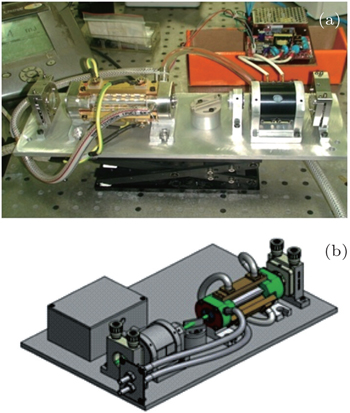 | Fig. 1. Experimental setup of a side-pumped electro-optical Q-switch Nd:YAG laser: (a) the picture of the setup, (b) schematic drawing of the setup. |
The unsymmetrical concave–concave is chosen for obtaining a nearly constant spot size and placing the Q-switch components inside one of its branches. The total length of the resonator is chosen to be 295 mm in order to have a compact laser. The back mirror is a plano-concave mirror and its concave surface is high-reflectivity coated at 1064 nm with a curvature radius of +2000 mm and the output mirror is a plano-concave output coupler mirror with a curvature radius of +3000 mm and a reflectivity of 25% at 1064 nm.
In this design, our final goal is to increase the pumping efficiency and suitability for easy assembling. Also the compactness and reliability are important. A schematic drawing of the pump head is illustrated in Fig.
The Nd:YAG rod used in the experiment has a length of 110 mm and a diameter of 3 mm with 1.1% Nd3+ dopant concentration. Both end faces of the rod are flat–flat and antireflection coated at 1064 nm in order to reduce the intra-cavity losses. The rod is pumped by 18 linear water-cooled diode lasers, and the energy of each diode laser is 22 mJ at the current of 100 A. Therefore, the total pumping energy is 400 mJ. The diode laser beam divergences are 38° in fast axis and 7 °C in slow axis. The center wavelength is 808 nm with a spectral width of 3 nm. The power supply used for driving the diode lasers can produce 32 V and 100 A current of total 1800 W. The diode laser bars are operated with a P.R.R. of 1−100 Hz and a pulse duration of 200 μs. The threshold and the slope efficiency of the diode laser bars are about 20 A and 57%, respectively.
The focal length of the thermal lens is measured by the setup shown in Fig.
The test is typically performed with a pump diode pulse width of 200 μs at P.R.R. of 1−100 Hz. At first, the Nd:YAG laser is operated at free-running mode without the polarizer, the quarter-wave plate, and the KD*P Q-switch. The light emitted from the Nd:YAG rod laser is linearly polarized by a polarizer, and then a phase difference of a quarter of the wavelength is introduced through a quarter-wave plate. A KD*P nonlinear crystal is employed as the Pockels cell Q-switch. In this work, a 10 mm × 10 mm × 25 mm KD*P crystal, coated with HT (> 99.9%) at 1064 nm on both ends, is used as the electro-optical Q-switch crystal. It has a high damage threshold (600 MW/cm2) and its extinction ratio is 1000/1 at 1064 nm. When the modulating device is inserted into the laser resonator, the actively Q-switched pulse is obtained. The result shows that the average output power and the pulse energy increase almost linearly with the increase of the pumping energy. The output energy versus electrical input current of the laser diodes in free-running and Q-switched modes is plotted in Fig.
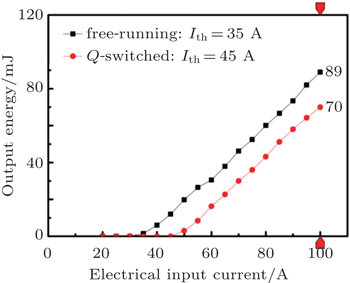 | Fig. 5. Laser output versus electrical input current of diode laser in free-running and Q-switched modes (at 100 Hz). |
 | Fig. 6. Laser output versus optical pump energy input characterized by a threshold input energy Eth and a slope efficiency σs (at 1 Hz) in (a) free-running and (b) Q-switched operations. |
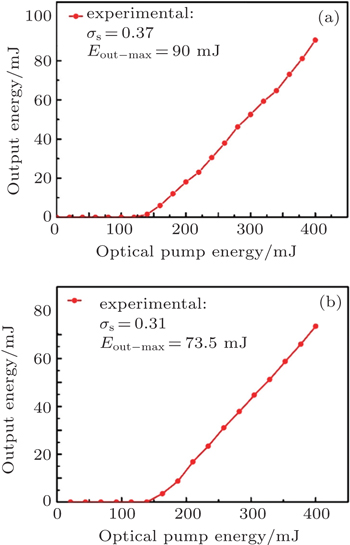 | Fig. 7. Laser output versus optical pump energy input characterized by a threshold input energy Eth and a slope efficiency σs (at 50 Hz) in (a) free-running and (b) Q-switched operations. |
 | Fig. 8. Laser output versus optical pump energy input characterized by a threshold input energy Eth and a slope efficiency σs (at 100 Hz) in (a) free-running and (b) Q-switched operations. |
The stability of the output energy at different P.R.R. from 1 Hz to 100 Hz is plotted in Figs.
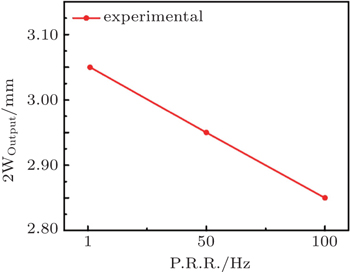 | Fig. 11. Stability of output beam spot size on the output mirror at P.R.R. of 1 Hz, 50 Hz, and 100 Hz. |
Finally, the temporal shape of the laser output pulse is shown in Fig.
A single head, uniformly three-side diode-pumped, pulsed Nd:YAG laser is used. To stabilize the output energy, the unsymmetrical concave–concave resonator is applied. The slope efficiency at free-running is 35%, while it is 29% in the Q-switch mode at 100 Hz. The total efficiency of the laser is 22.25% at free-running and 17.5% in the Q-switch operation. The pulse width of the laser is about 7 ns, which corresponds to 10 MW peak power. This type of laser is developed and it is of interest in range-finder and LIDAR systems since the output energy and the spot size have good stability.
| 1 | |
| 2 | |
| 3 | |
| 4 | |
| 5 | |
| 6 | |
| 7 | |
| 8 | |
| 9 | |
| 10 | |
| 11 | |
| 12 |



